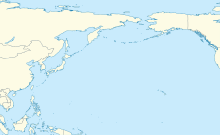Gwangju Airport (IATA: KWJ, ICAO: RKJJ) is an airport in the city of Gwangju, South Korea and is managed by the Korea Airports Corporation. In 2018, 1,986,125 passengers used the airport. This airport is planned to close when Muan International Airport becomes more established. Because Gwangju Airport is sharing with military, taking photograph or video of apron, runway and military facility is strictly prohibited.
Gwangju Airport 광주공항 | |||||||||||||||
|---|---|---|---|---|---|---|---|---|---|---|---|---|---|---|---|
 | |||||||||||||||
| Summary | |||||||||||||||
| Airport type | Public / Military | ||||||||||||||
| Owner | Ministry of Land, Infrastructure and Transport | ||||||||||||||
| Operator | |||||||||||||||
| Serves | Gwangju | ||||||||||||||
| Location | Sinchon-dong, Gwangsan-gu, Gwangju, South Korea | ||||||||||||||
| Opened | November 1964 | ||||||||||||||
| Elevation AMSL | 49 ft / 15 m | ||||||||||||||
| Coordinates | 35°07′35″N 126°48′32″E / 35.12639°N 126.80889°E | ||||||||||||||
| Website | www | ||||||||||||||
| Map | |||||||||||||||
| Runways | |||||||||||||||
| |||||||||||||||
| Statistics (2019) | |||||||||||||||
| |||||||||||||||
Statistics from KAC[1] | |||||||||||||||
| Gwangju Airport | |
| Hangul | 광주공항 |
|---|---|
| Hanja | 光州空港 |
| Revised Romanization | Gwangju Gonghang |
| McCune–Reischauer | Kwangju Konghang |
History edit
The airport was established in November 1948. It saw its first commercial flight in 1950. At the time, however, it was not located in Gwangju but in neighboring Jangseong, on a military training facility. The airport moved to its present location in Sinchon-dong, Gwangsan-gu, in 1964. It was taken over by the Korea Airports Corporation in 1990. The current airport terminal was built in 1994, at which time the old terminal was repurposed as a Cargo terminal.
Airlines and destinations edit
| Airlines | Destinations |
|---|---|
| Asiana Airlines | Jeju, Seoul–Gimpo |
| Jeju Air | Jeju |
| Jin Air | Jeju |
| Korean Air | Jeju |
| T'way Air | Jeju |
Statistics edit
Graphs are unavailable due to technical issues. There is more info on Phabricator and on MediaWiki.org. |
| Aircraft operations | Passenger volume | Cargo tonnage | |
|---|---|---|---|
| 2001 | 12,660 | 2,234,855 | 30,628 |
| 2002 | 14,056 | 2,129,521 | 30,750 |
| 2003 | 16,112 | 2,081,031 | 32,979 |
| 2004 | 15,185 | 1,879,968 | 28,260 |
| 2005 | 13,715 | 1,642,129 | 24,771 |
| 2006 | 13,558 | 1,629,787 | 23,872 |
| 2007 | 12,700 | 1,539,187 | 22,942 |
| 2008 | 11,166 | 1,380,636 | 16,409 |
| 2009 | 10,747 | 1,363,122 | 13,146 |
| 2010 | 10,315 | 1,348,847 | 15,388 |
| 2011 | 10,781 | 1,375,839 | 15,317 |
| 2012 | 10,899 | 1,380,071 | 14,662 |
| 2013 | 10,819 | 1,332,234 | 15,143 |
| 2014 | 11,574 | 1,470,096 | 15,373 |
| 2015 | 12,258 | 1,604,905 | 15,796 |
| 2016 | 10,792 | 1,613,775 | 14,818 |
| 2017 | 12,678 | 1,946,605 | 15,592 |
| 2018 | 13,546 | 1,986,125 | 14,477 |
| 2019 | 13,297 | 2,026,651 | 12,500 |
| 2020 | 13,575 | 1,726,483 | 7,428 |
| 2021 | 14,764 | 2,152,892 | 8,679 |
| 2022 | 12,916 | 2,068,625 | 9,144 |
| 2023 | 13,277 | 2,050,378 | 9,549 |
| Source: Korea Airports Corporation Traffic Statistics[2] | |||
Ground transportation edit
Metro edit
Line: Pyeongdong - Songjeongri(KTX Station) - Airport - Sangmu - Nongseong - Geumnamro4ga - Nokdong
Bus edit
- No. Songjeong 97 : Airport ↔ Gwangju Songjeong Station ↔ Daesan ↔ Chilseong ↔ Gwangam
- No. Seonun 101 : Airport ↔ Songjeong Park Station ↔ Gwangsan Police Station ↔ Honam University Gwangsan Campus
- No. 1000 : Airport ↔ Gwangju Songjeong Station ↔ Kim Daejung Convention Center ↔ City Hall ↔ U Square(Gwangju Bus Terminal) ↔ Geumnam-ro ↔ Chosun University ↔ Gwangju Court ↔ Jisan Yuwonji
- No. 1160(Naju) : Airport ↔ Naju ↔ Yeongsanpo Bus Terminal
Parking lot edit
Customers should pick up a parking ticket from a printing machine on the way into the lot. If customers do not pick up the ticket, they have to pay the full fare.[3]
See also edit
References edit
- ^ "공항별 통계 : 항공통계 : 알림·홍보 : Kac 한국공항공사". Archived from the original on 20 January 2019. Retrieved 20 January 2019.
- ^ "Air Traffic Statistics". Incheon International Airport. Retrieved 15 December 2021.
- ^ "Gwangju Airport parking". Archived from the original on 2007-08-08.
- "Gwangju Airport". Tour2Korea. Archived from the original on July 29, 2005. Retrieved June 25, 2005.
- "Gwangju Airport". Korea Airports Corporation website. Archived from the original on May 17, 2005. Retrieved June 25, 2005.
External links edit
- Official Site (in English)



